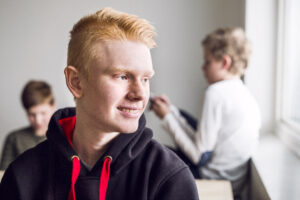By Amanda Langelaan & Angelique Jenney.
Spanking has been a traditional method of child discipline used by parents. In fact, it’s estimated that up to 43% of Canadian families use spanking to discipline their children. However, as child protection legislation has shifted over the years, its effectiveness is being questioned in light of new research. As we strive to create a nurturing environment for our children, it is now necessary to differentiate between reasonable forms of physical correction and abusive actions and explore alternatives to physical punishment.
There are many reasons why parents and caregivers might use physical forms of punishment such as hitting, spanking, pinching, or slapping their children as part of disciplinary action. These physical forms of discipline, called corporal punishment (CP), are likely familiar to many of us and we often parent in similar ways as how we ourselves were parented.
In the past, spanking was perceived as an acceptable means of disciplining children. Many individuals recall their own experiences of CP and believe that it has had positive impacts on their character and behaviour over time. In fact, the myths around CP are so prevalent researchers even developed a scale for them that was directly linked to disciplinary actions.
Today, research shows that any form of physical punishment, including spanking, can have many negative outcomes for children. Surprisingly, over the last two decades, researchers have found no evidence of any benefits. Now that is something to consider.
This seems like a huge departure from that old saying, ‘spare the rod, spoil the child’ wherein many parents learned that physical punishment was a way of bringing up children who were respectful and behaved well, and yet that’s not what the research tells us. In fact, we now know that spanking can lead to issues with aggression, antisocial behaviour, and even substance use. Newer research is also showing that spanking can cause children to feel constantly threatened, leading to trust issues and a fight-or-flight response. Alarming connections have also been made between spanking and poor parent-child relationships, heightened risks of suicidality, and even domestic violence in later life.
One of the things we know about behaviour is that it’s a child’s primary means of communication. So before we attempt to modify behaviour, first we have to understand what our child is trying to tell us with it. Are they angry, scared, sad? Are they feeling out of control of their emotions and bodies and need an adult to help them calm down (think temper tantrums)? Are they growing and learning and developing like they should (children who drop food or dishes from their highchair are actually learning about gravity and spectacular noises) rather than misbehaving (it’s fun for them, even though it’s not for us). Sometimes our children aren’t ‘being bad’ – they are being normal kids and learning about the world around them. The other thing we need to consider is how they learn at that moment in time. Even consequences need to be developmentally appropriate. For example, the use of “Time Out” – once thought an effective behaviour management strategy, over time it has been shown to be harmful, especially when used with children who lack the developmental capacity to benefit from it. For example, if the child is too young to control their behaviour, then being told to stand in a corner will only result in failure as the child repeatedly tries to access the caregiver for relief from their distress. This has led to some suggestions that Time In would be more effective, where children can spend time with their parent learning about emotion management rather than being punished with feelings of rejection and isolation.
Knowing that we only want the best for our children, it’s helpful to learn about the many other alternative solutions to managing children’s behavior that are more positive, effective, and loving:
- Keep Calm. By far, the most important (and often the hardest) is to stay calm yourself. If we can’t keep ourselves calm, it will be that much harder to respond the way we want to.
- Increase desired behaviours. When we tell children we don’t want them to do something, they usually don’t know what to do instead. Depending on their age and development, it’s also helpful for them to understand why. If they hit someone, remind them to use gentle hands and demonstrate what that looks like. Discover other ways of managing their angry feelings that don’t involve hitting anything or anyone.
- Set up the environment for success by managing the environment to avoid temptation. For example, if your child likes to spill their drink on purpose, try to understand that at this stage in development, children love to watch things spill and get reactions out of us! They are like little scientists testing their theories over and over, and not being difficult on purpose. To help manage these situations better, try to give them a sippy cup that is spill-proof, and provide fun and appropriate places to spill water cups such as in a backyard or the bathtub.
- Find Safe Spaces. When children are overwhelmed, taking them out of the situation can sometimes be the best way to help them calm down. We can then focus on helping them manage those emotions in the moment. If you know that your child struggles with being in a space such as the grocery store, then plan in advance; bring a game or toy that your child can play with while you do the shopping and always bring a favourite snack to avoid the temptation of the treats in the checkout aisle.
- Spend more quality time together. Make sure you get positive quality time together. Having a closer relationship will give them the attention they are looking for in a positive way, plus it helps improve their behaviour overall and increases both of your positive feelings towards each other. Not sure where to start? This free parent-child activity game uses common items around the house to engage your child in play and learning together. Try to limit access to devices as research is showing that screen time distracts parents and children from having higher-quality interactions, disrupts sleeping patterns, and impacts creativity as well as impulse control.
- Use natural consequences and opportunities to problem-solve together when things go wrong. Natural consequences are the things that will happen as a direct result of behaviour such as leaving a toy out in the rain that gets damaged. Problem-solve together how to avoid forgetting to clean up, or how an item might be repaired or replaced – these will make for great life skills later on. After all, physical punishment only teaches children to fear their parent and fear getting caught, it doesn’t actually teach prosocial skill development.
These are just a few ideas to get started, and beginning with implementing one of them is a great way to begin a new process of behaviour management in your household. If you want more support with implementing any of these ideas, try connecting with your local family support organization for some one-on-one assistance.
Want to know more?
65 states and countries worldwide have already banned all forms of physical punishment against children but Canada has yet to join this list, and that needs to change!
Right now, Canada still allows corporal punishment under Section 43 of the Criminal Code of Canada, but it has several restrictions that limit the physical force used, but it still leaves too much room for children to be seriously harmed in physical and emotional ways. The good news is that Bill S-251 is currently being debated in the Senate of Canada, and having it pass would make corporal punishment banned in Canada. Banning corporal punishment would not mean that parents who get caught spanking would be arrested or put in jail, but they would instead be supported to help them reduce this behavior. If you would like to support Bill S-251, you can write a letter to Senator Stan Kutcher by emailing [email protected] or by standard mailing address (free postage):
Office of Senator Stan Kutcher
Senate of Canada
Ottawa (ON)
K1A OA4
Additional Resources:
Time to abolish the Canadian law that allows adults to spank and hit children (theconversation.com)
The Effect of Spanking on the Brain | Harvard Graduate School of Education
Amanda Langelaan, BA, is a University of Calgary student based in the Lethbridge area who is currently completing her BSW senior practicum placement with Dr. Angelique Jenney, the Wood’s Homes Research Chair. She also works as a Child & Youth Development Specialist with AHS and is very passionate about promoting children’s mental health and preventing adverse childhood experiences.




